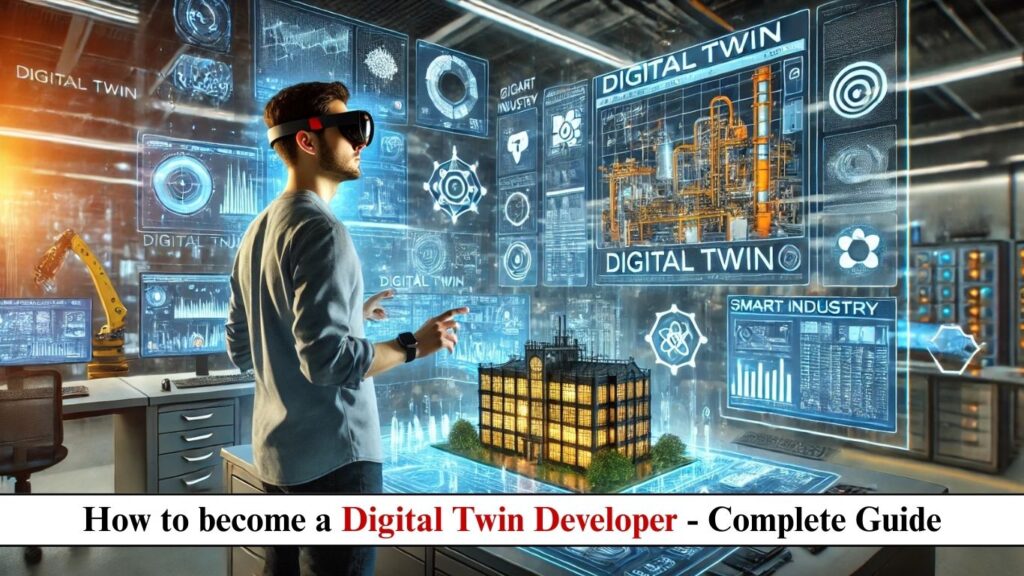
Introduction to Digital Twin Technology
The digital twin market is projected to reach $125 billion by 2030, transforming industries from manufacturing to healthcare. Digital Twin Developers create virtual replicas of physical systems that enable real-time monitoring, simulation, and predictive analytics. These professionals combine IoT, AI, and 3D modeling expertise to build the next generation of smart systems.
This guide covers:
- Evolution of digital twin technology
- Global salary benchmarks
- Core responsibilities
- Required technical stack
- Step-by-step career path
- Future industry applications
Whether you’re a software engineer, data scientist, or industrial designer, this guide reveals how to break into this cutting-edge field.
History of Digital Twins
Early Concepts (1960s-2000)
- 1960s: NASA develops mirror systems for spacecraft
- 2002: Dr. Michael Grieves coins “digital twin” concept
- 2006: First industrial applications in product lifecycle management
IoT Integration Era (2010-2018)
- 2013: GE implements jet engine digital twins
- 2016: Siemens launches MindSphere platform
- 2018: Singapore creates virtual city model
AI Revolution (2019-Present)
- 2020: Microsoft Azure Digital Twins GA release
- 2022: Human digital twins enter clinical trials
- 2024: Nvidia Omniverse enables real-time physics simulations
Digital Twin Developer Salary (2024)
| Experience Level | Average Salary (US) | Industry Variations |
|---|---|---|
| Entry-Level (0-2 yrs) | $85,000-$110,000 | +25% in automotive |
| Mid-Career (3-5 yrs) | $110,000-$150,000 | +35% in aerospace |
| Senior (5+ yrs) | $150,000-$220,000 | +50% in healthcare |
Specialty Premiums:
- Physics-based modeling: +$20,000
- Edge computing integration: +$15,000
- Generative AI twins: +$30,000
Roles & Responsibilities
1. System Architecture
- Design twin-data pipelines with IoT sensors
- Implement time-series databases (InfluxDB, Timescale)
- Configure event-driven triggers
2. 3D Modeling & Simulation
- Develop CAD-to-twin converters (PTC Creo, SolidWorks)
- Build physics engines (NVIDIA PhysX, Unity DOTS)
- Simulate stress scenarios via FEA
3. AI Integration
- Train predictive maintenance models
- Implement computer vision twins
- Develop conversational twin interfaces
4. Industry-Specific Solutions
- Manufacturing: Production line optimization
- Healthcare: Patient-specific organ models
- Smart Cities: Traffic flow simulation
5. Performance Optimization
- Reduce latency in edge deployments
- Implement delta encoding for efficiency
- Maintain version control for twin evolution
Required Qualifications
Technical Skills Matrix
| Category | Essential Technologies |
|---|---|
| Programming | Python, C++, C#, JavaScript |
| IoT Platforms | Azure Digital Twins, AWS IoT TwinMaker |
| 3D Tools | Unity, Unreal Engine, Blender |
| Data Science | PyTorch, TensorFlow, Pandas |
| Protocols | MQTT, OPC UA, WebSockets |
Certification Pathway
- Foundational:
- Microsoft Certified: Azure IoT Developer
- AWS Certified IoT Specialty
- Advanced:
- Siemens Digital Twin Professional
- Nvidia Omniverse Certification
- Domain-Specific:
- ANSYS Simulation Specialist
- Dassault Systèmes Twin Expert
How to Get Started: 5-Step Roadmap
Step 1: Build Core Skills
- Complete Udacity’s Digital Twin Nanodegree
- Master IoT data pipelines with Raspberry Pi
- Learn industrial protocols (OPC UA, Modbus)
Step 2: Gain Practical Experience
- Entry-Level Roles:
- IoT Developer (70k−70k−90k)
- CAD Automation Engineer
- Hands-On Projects:
- Build a smart home digital twin
- Contribute to open-source twin projects
Step 3: Specialize
- High-Demand Niches:
- Manufacturing execution systems
- Biomedical human twins
- Energy grid simulations
Step 4: Build Portfolio
- Showcase twin visualization dashboards
- Document predictive accuracy metrics
- Publish case studies on GitHub
Step 5: Target Employers
- Industry Leaders:
- GE Digital Twin Command Center
- Siemens Xcelerator
- Philips HealthSuite
Future Scope & Trends
1. Emerging Applications
- 2025: Cognitive digital twins with LLM integration
- 2027: Quantum twins for molecular modeling
2. Market Expansion
- 300% growth in healthcare twins by 2026
- $50B opportunity in climate resilience modeling
3. Career Innovations
- Twin Security Specialists
- Metaverse Twin Architects
- Regulatory Compliance Auditors
Conclusion: Is This Career Right For You?
✅ Ideal Candidate:
- Strong multidisciplinary aptitude
- Passion for systems thinking
- Comfort with rapid technology shifts
🚀 Action Plan:
- Master IoT + 3D modeling fundamentals
- Complete cloud platform certifications
- Network at Digital Twin Consortium events
- Specialize in one vertical industry
With 80% of IoT platforms expected to incorporate digital twins by 2025, developers will enjoy strong career longevity.
Want our free digital twin project checklist? Comment below!
Questions about transitioning from game development? Ask here!













Post Comment